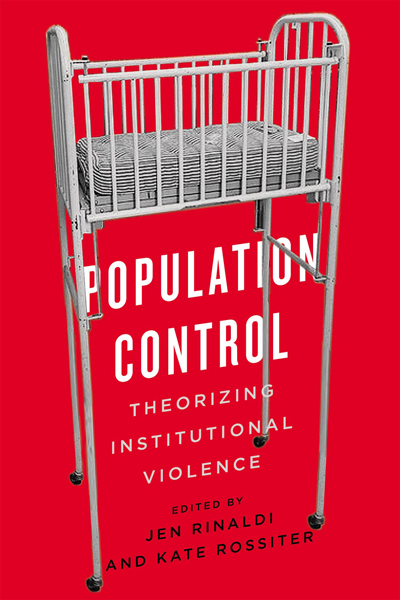About the authors | About the book | Author's notes
"Population Control offers a new perspective on institutionalization, which is not just a form of spatial organization, but rather a logic, or way of thinking about how to manage marginalized populations."
About the authors

Jen Rinaldi is a socio-legal scholar at Ontario Tech University who uses critical arts-informed and participatory action research methods to study institutional and carceral violences. With the research collective Recounting Huronia, she documented survivor-centric histories of institutionalization. Her books with Kate Rossiter include Institutional Violence and Disability: Punishing Conditions, and Population Control: Theorizing Institutional Violence. She has served as a regional advocate for the Canadian Association of Elizabeth Fry Societies Ontario team for two years.

Kate Rossiter is an Associate Professor in the Department of Health Studies at Wilfrid Laurier University’s Brantford campus. Her background combines the critical social scientific study of public health and embodiment with theatre and performance studies, and her award-winning research work is cross-disciplinary, combining critical health and disability studies with participatory and arts-based methodologies. For the past decade, Dr, Rossiter has been the PI of “Recounting Huronia,” a long term research project which aims to explore developmental disability and experiences of institutionalization and institutional violence, with particular focus on the Huronia Regional Centre.. She is interested in the structural conditions of violence engendered by and within putative care organizations, and specifically the ways in which discourses of security are engenders as a means to dehumanize institutionalized populations.
About the book

Violence is an inescapable through-line across the experiences of institutional residents regardless of facility type, historical period, regional location, government or staff in power, or type of population.
Population Control explores the relational conditions that give rise to institutional violence - whether in residential schools, internment camps, or correctional or psychiatric facilities. This violence is not dependent on any particular space, but on underlying patterns of institutionalization that can spill over into community settings even as Canada closes many of its large-scale facilities. Contributors to the collection argue that there is a logic across community settings that claim to provide care for unruly populations: a logic of institutional violence, which involves a deep entanglement of both loathing and care. This loathing signals a devaluation of the institutionalized and leaves certain populations vulnerable to state intervention under the guise of care. When that offer of care is polluted by loathing, however, there comes along with it an unavoidable and socially prescribed violence.
Offering a series of case studies in the Canadian context - from historical asylums and laundries for “fallen women” to contemporary prisons, group homes, and emergency shelters - Population Control understands institutional violence as a unique and predictable social phenomenon, and makes inroads toward preventing its reoccurrence.
Population Control offers a new perspective on institutionalization, which is not just a form of spatial organization, but rather a logic, or way of thinking about how to manage marginalized populations. This allows us to reimagine many spaces as potential sites of institutional violence, and to describe what kind of impact this violence may have. Our analysis of where and how institutional violence occurs is critical as governments enact new practices to manage groups framed as socially disruptive.
